Physical Address
304 North Cardinal St.
Dorchester Center, MA 02124
Inflammatory diseases of the subcutaneous fat are a source of considerable confusion and often cause diagnostic difficulty to clinicians and pathologists alike. This stems in part from the use of classifications and clinical descriptions based on time-honored but outdated literature. Inadequate biopsy specimens are also a source of considerable difficulty, particularly the punch biopsy specimen, which often yields no subcutaneous fat at all. Similarly, histologic subdivision into diseases that affect the lobule and those that affect the septa is to some extent artifactual and sometimes unrewarding since most disorders affect both. There is also a somewhat monotonous clinical presentation, with most patients complaining of deep-seated, variably tender or painful nodules, often affecting the lower extremities.
The subcutaneous fat has a limited repertoire of responses to noxious stimuli. Fat necrosis is a common manifestation of many forms of panniculitis and, as a consequence, there is often considerable histologic overlap. Although there are many variants of fat necrosis – including enzymatic, crystalline, suppurative, hyalinizing, and microcystic – lipophagic fat necrosis is the subtype most commonly encountered and is often a secondary feature in many forms of panniculitis ( Fig. 10.1 ). This is characterized by a lobular infiltrate of histiocytes, xanthomatized cells, and foreign body giant cells, frequently accompanied by granulomata ( Fig. 10.2 ).
It is important to remember that the subcutaneous fat may be involved in a secondary manner, for example, in the vasculitides, the deep cutaneous fungal infections, by metastatic tumor, and following surgery or radiotherapy ( Figs 10.3 and 10.4 ). In this chapter, the panniculitides are classified, where possible, on an etiological basis ( Table 10.1 ).
| Mostly septal panniculitis |
|
| Mostly lobular panniculitis |
|
| Others |
| Eosinophilic panniculitis |
There is considerable histologic overlap in the various types of panniculitis, and one must take into account all the clinical information before attempting to reach a definitive diagnosis. In patients in whom the diagnosis of panniculitis is suspected, a deep surgical incisional biopsy is essential ( Fig. 10.5 ). The punch biopsy has no role whatsoever in the diagnosis of panniculitis.
Erythema nodosum represents the most common form of nodular panniculitis and is the prototype of septal panniculitis. It is, of course, a clinical syndrome rather than a specific disease in its own right, representing a complex of symptoms and signs with multiple and very variable etiologies. It typically affects young adults and shows a marked predilection for women (as high as 9 : 1 in some series). Children are only rarely affected. Patients present with a sudden onset of bright red, warm, tender nodules; these typically affect the anterior and lateral aspects of the lower legs, but the arms, face, calves, and trunk are occasionally involved ( Figs 10.6 and 10.7 ). Involvement of the soles of the feet is rare, although it appears to be more often encountered in children. The lesions are usually multiple, bilateral, symmetrically distributed, elevated above the skin surface, and measure 1–15 cm in diameter. Ulceration and scarring are not features. Subsequently, the erythema fades to a bluish or livid hue and then to a yellow discoloration, reminiscent of a bruise ( Fig. 10.8 ). The duration of the illness is 3–6 weeks. Patients sometimes also have pyrexia, malaise, and vague aches and pains in the joints. Laboratory findings may include a raised erythrocyte sedimentation rate (ESR), leukocytosis, and mild anemia.
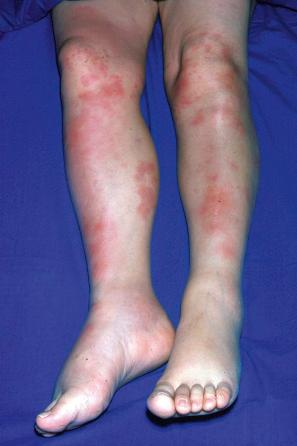
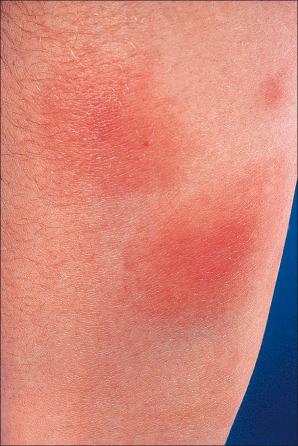
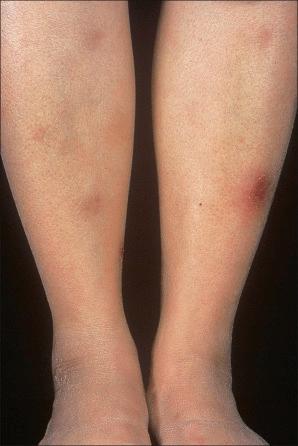
Two clinical variants have been described.
Erythema nodosum migrans (subacute nodular migratory panniculitis, migratory panniculitis) is similar to classic erythema nodosum, but the lesions appear to migrate due to central clearing of established lesions and the development of new nodules at the periphery. The lesions, which may persist for months or years, are usually associated with only mild symptoms. Recurrences are sometimes encountered. Scarring is not a feature. This variant is typically asymmetrical, unilateral, and distributed solely on the leg. It also shows a marked female predominance (approximately 9 : 1), but tends to affect an older age group than classic erythema nodosum (mean age, 50 years).
Chronic erythema nodosum, a somewhat controversial entity, is characterized by the presence of nodules over a course of months or even years. Otherwise, the clinical features appear indistinguishable from the more typical condition.
The etiology and pathogenesis of erythema nodosum are unknown. Despite the very occasional finding of immunoreactants (IgM or IgG, and C3) in the blood vessel walls, an immune complex-mediated vasculitis is not considered likely. It is probable that erythema nodosum represents a non-specific hypersensitivity reaction that involves delayed hypersensitivity mechanisms in addition to a type 3 component.
There are many known associations. Although some are certainly of significance in the etiology of this dermatosis, many are probably coincidental ( Table 10.2 ). In the earlier part of the twentieth century, tuberculosis was noted in up to 90% of adult patients with erythema nodosum, but this is now found in less than 1% of cases. Today, the more frequent associations include streptococcal infections, sarcoidosis, ulcerative colitis and Crohn disease, Sweet syndrome, Behçet disease, menstruation, pregnancy, estrogens and the oral contraceptive, cat scratch disease, and various drug treatments (e.g., bromides, antibiotics, and sulfonamides). Other infectious conditions that have been described in association with erythema nodosum include cytomegalovirus, Epstein-Barr virus, parvovirus b19, Yersinia , Mycoplasma , Brucella , Bartonella , Rickettsia , Cryptococcus , Salmonella , Shigella , Chlamydia , Chlamidophila pneumonia , Helicobacter pylori , hepatitis B, atypical mycobacterial infections (e.g., swimming pool granuloma), meningococcal septicemia, Q fever, leptospirosis, syphilis, human immunodeficiency virus (HIV), kerion, histoplasmosis, blastomycosis, amebiasis, ascaris, Staphylococcus xylosus , Sporothrix schenckii , Trichophyton mentagrophytes , and giardiasis. Simultaneous occurrence of erythema nodosum in monozygotic twins following streptococcal pharyngitis has also been reported.
| Streptococcus | Sarcoidosis |
| Tuberculosis | Sweet syndrome |
| Chlamydophila psittaci | Cat scratch disease |
| Crohn disease | Yersinia infection |
| Drugs | Ulcerative colitis |
| Behçet disease | Malignancy |
Additional drugs that have been implicated in the development of erythema nodosum include isotretinoin, interleukin (IL)-2, minocycline, thalidomide, echinacea, gold salts, vaccines (hepatitis B, tetanus-diphtheria-pertussis, cholera, human papillomavirus, malaria, rabies, small pox, tuberculosis, typhoid), all- trans -retinoic acid, capecitabine, azathioprine, aromatase inhibitors, cabergoline, valproate, terbinafine, BRAF inhibitors (vemurafenib, dabrafenib), sulfasalazine, anti-TNF therapy, and lidocaine. Erythema nodosum has also been reported following a variety of malignancies including Hodgkin lymphoma, myelodysplastic syndrome, hairy cell leukemia, acute myeloid leukemia, acute myelomonocytic leukemia, diffuse large B-cell lymphoma, hypernephroma, non-small cell lung carcinoma, pheochromocytoma, carcinoid tumor, hepatocellular carcinoma, carcinomas of the colon, pancreas, and uterine cervix, and after radiotherapy. In 20–30% of patients, no obvious cause is identified (idiopathic erythema nodosum). Erythema nodosum in renal transplant recipients can be related to infections, malignancies, drugs, inflammatory bowel disease, or autoimmune diseases.
Erythema nodosum has rarely been described in association with other diverse conditions, including idiopathic granulomatous mastitis, diverticulitis, pernicious anemia, Gianotti-Crosti syndrome, and autoimmune hepatitis.
Erythema nodosum migrans seems to be particularly related to pregnancy, the oral contraceptive, streptococcal infection, and thyroid disease. Many cases, however, have no obvious associated predisposing factors or conditions.
Histologically, erythema nodosum represents the prototype of septal panniculitis. It is characterized by a combination of features, including vascular change, septal inflammation, hemorrhage, and a variable degree of acute or chronic panniculitis ( Fig. 10.9 ). Although it is often said that erythema nodosum characteristically affects the septal component of the panniculus, it should be noted that there is not infrequently involvement of the lobule, in part or in whole, particularly if older lesions are biopsied. In the past, cases of the latter might have been diagnosed as Weber-Christian disease.
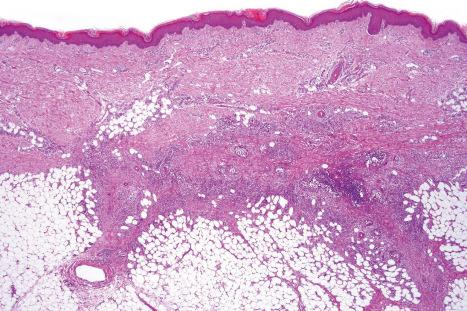
Frank vasculitis is only very exceptionally encountered. When present, it involves the small veins, and very occasionally medium-sized vessels within the connective tissue septa. It may be acute and necrotizing, associated with thrombosis and hemorrhage, or may manifest as chronic venular inflammation associated with endothelial cell swelling ( Figs 10.10 and 10.11 ). The overlying dermis typically shows a perivascular and periadnexal chronic inflammatory cell infiltrate.
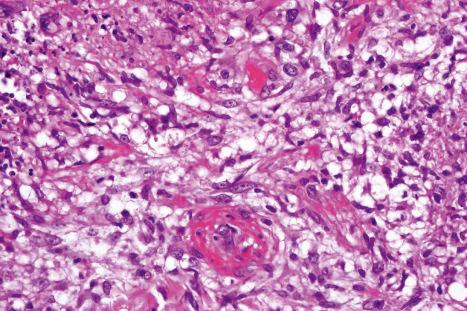
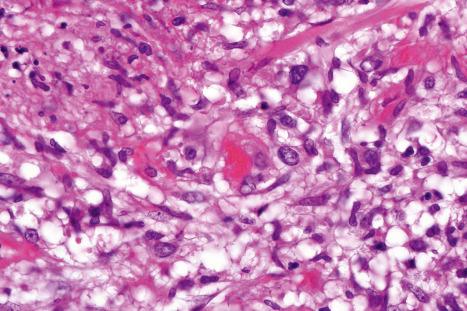
In the early stages, the septal inflammation may be acute, characterized by an infiltrate of neutrophil polymorphs, but this is soon replaced by lymphocytes and histiocytes ( Figs 10.12–10.14 ). Eosinophils are sometimes found, and rarely they can be conspicuous. Septal collections of histiocytes surrounding a cleftlike space (so-called Miescher radial granuloma) are said to be a characteristic feature, although they have been reported in Sweet syndrome, nodular vasculitis, and necrobiosis lipoidica ( Figs 10.15–10.17 ). Further progression leads to the development of a frankly granulomatous infiltrate in which giant cells may be conspicuous. Coagulation and caseation-like necrosis are never seen in erythema nodosum (compare with nodular vasculitis below). Sometimes the connective tissue in the fibrous septa shows fibrinoid necrosis, and hemorrhage is almost invariably present ( Figs 10.18–10.20 ).
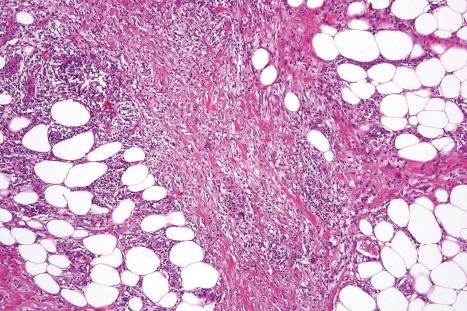
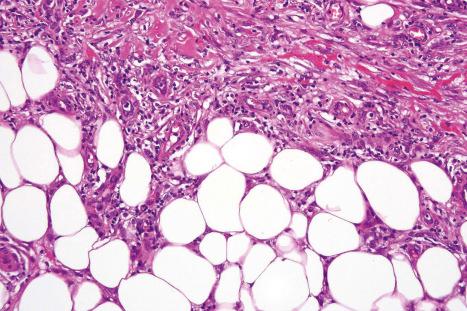
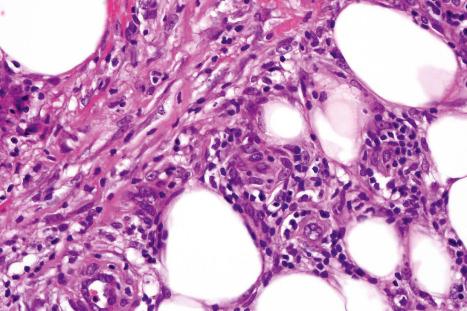
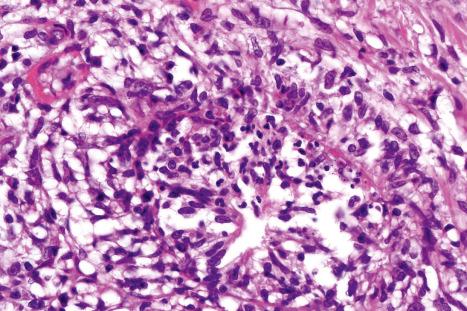
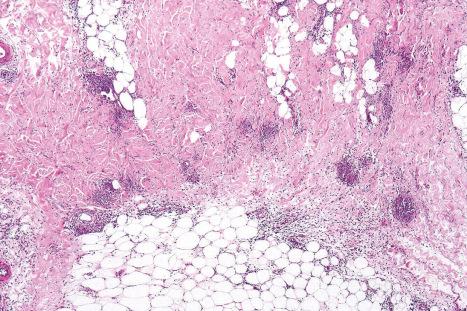
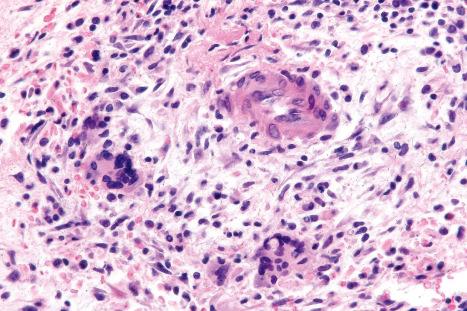
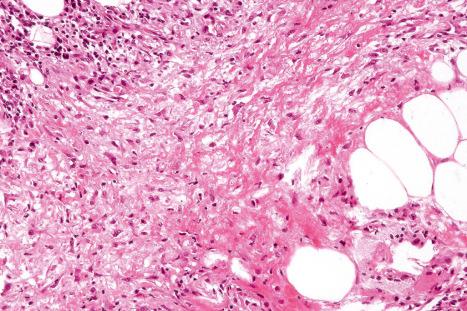
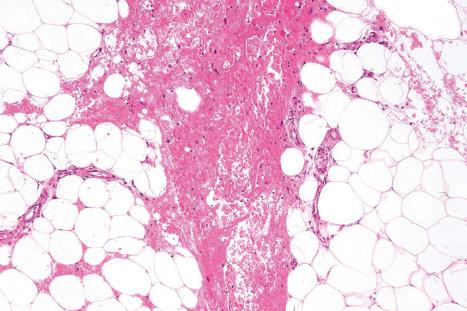
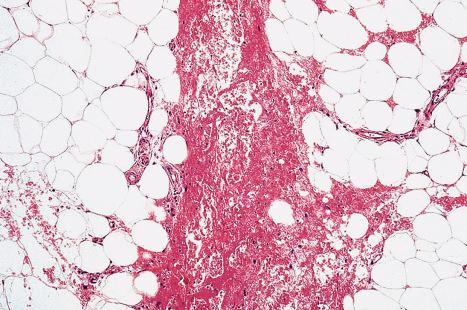
Characteristically, the septal infiltrate (lymphocytes, histiocytes, and granulomata) spills over to affect the periphery of the fat lobule to give a delicate lacy appearance, but fat necrosis is not usually present. On occasion, however, otherwise typical erythema nodosum may be associated with fat necrosis and a neutrophil inflammatory cell infiltrate ( Fig. 10.21 ).
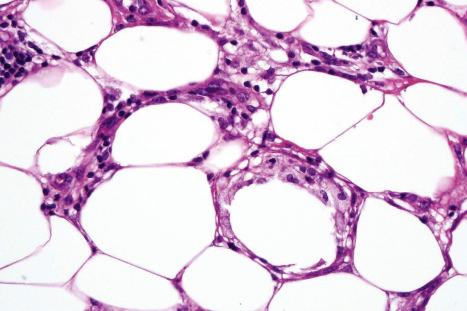
If an older lesion is biopsied, septal fibrosis can sometimes be quite marked. Residual granulomatous inflammation is usually present.
Erythema nodosum migrans is characterized by densely scarred and thickened interlobular septa accompanied by a conspicuous granulomatous infiltrate ( Figs 10.22 and 10.23 ). Numerous giant cells may be seen, and often they form a palisade along the septal borders. Granulation tissue-like vascular proliferation is often a conspicuous feature. Vasculitis is absent and hemorrhage is not usually seen.
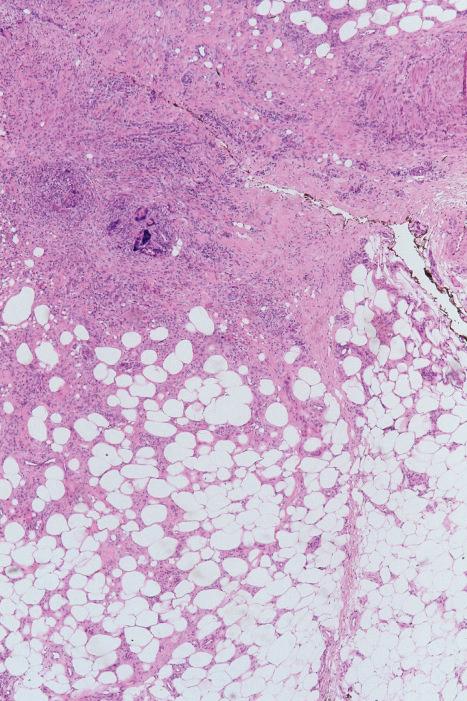
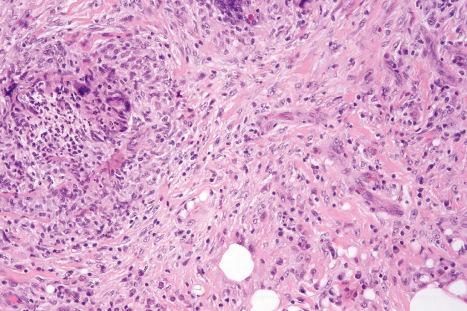
In chronic erythema nodosum, the histologic changes are similar to, but usually milder, than those of the acute variant.
At scanning magnification, vasculitic processes affecting the septa of the subcutaneous fat may be mistaken for erythema nodosum. Occasionally, the features of leukocytoclastic vasculitis are seen within the septa in the absence of the more usual superficial dermal involvement. Such instances present as erythematous nodules, usually affecting the lower legs. Similarly, superficial thrombophlebitis presents within the subcutaneous fat septa. In this condition, however, the vein is the focus of the inflammatory process with associated thrombosis, and there is little or no involvement of the lobule. Cutaneous polyarteritis nodosa affects muscular arteries within the lower dermis and subcutaneous fat septa and, therefore, should not be confused with erythema nodosum. Nephrogenic systemic fibrosis can rarely be associated with mild septal mononuclear cell infiltrates and granulomata, thereby simulating erythema nodosum.
Recurrent erythematous, tender, nodular lesions on the lower extremities (clinically reminiscent of erythema nodosum) are a common manifestation of Behçet disease. Erythema nodosum-like lesions develop in more than 40% of the patients during the course of the disease. Erythema nodosum-like lesions and superficial thrombophlebitis could represent predictive markers for visceral involvement. Furthermore, male patients with erythema nodosum-like lesions in Behçet disease have an increased risk for deep vein thrombosis.
The fronts of the shins are most often affected, but lesions may also occur on the arms, face, neck, and buttocks. Although histologically they have been described as showing erythema nodosum-like features, more commonly they are characterized by a lobular or mixed septal and lobular panniculitis associated with a neutrophil-rich infiltrate, neutrophilic vasculitis (affecting arterioles and venules), and associated fat necrosis. Less often, a lymphocytic vasculitis and, exceptionally, polyarteritis nodosa-like features are encountered. Miescher granulomata may sometimes be present.
A recent study of 26 patients with Behçet disease and erythema nodosum-like lesions classified histologic changes into those indistinguishable from conventional erythema nodosum (27% of the lesions), and erythema nodosum-like lesions with vasculitis (venulitis or phlebitis). In contrast to previous reports, arteries or arterioles were not involved in the vasculitic process. Patients with lesions indistinguishable from erythema nodosum were associated with a mild clinical course of Behçet disease, while those with severe vasculitis were at risk to develop gastrointestinal tract involvement.
As originally defined by Christian in 1928 (relapsing febrile nodular nonsuppurative panniculitis), this disorder was characterized by recurrent attacks of fever associated with the development of subcutaneous tender nodules (particularly over the extremities), which were histologically characterized by the presence of nonsuppurative panniculitis which healed to leave a depressed scar. Lesions were said to affect mainly young white females, and although the lower extremities were predominantly affected, the upper extremities, buttocks, abdominal wall, breasts, and face could also be involved. Arthritis, arthralgias, and myalgias were often present. A systemic variant – which was potentially fatal and affected the intestines, mesentery, lungs, heart, and kidneys – was also recognized. A presumed case of Weber-Christian disease developing during pregnancy has also been reported.
Since 1928, there have been many case reports in the literature dealing with this so-called ‘specific disease’. In general, however, many of the (particularly earlier) studies used imprecise clinical and histologic diagnostic criteria. Some were certainly examples of erythema nodosum. In the light of current knowledge of the panniculitides, many cases would now be reclassified. A Weber-Christian-like disease may be seen in erythema nodosum, factitial panniculitis, lupus panniculitis, pancreatic fat necrosis-associated panniculitis, α 1 -antitrypsin deficiency-associated panniculitis, connective tissue diseases, infectious panniculitis (e.g., Mycobacterium chelonae ), subcutaneous panniculitic T-cell lymphoma, and gamma-delta T-cell lymphoma. The term has also been applied to cases of infective panniculitis, and panniculitis following jejunoileal bypass surgery.
It seems unlikely, therefore, that Weber-Christian disease represents a distinct entity in its own right. It is proposed, therefore, to take this opportunity to bury it once and for all. As suggested by Patterson, ‘a clinical diagnosis of Weber-Christian disease should signal the beginning of a search for the true cause of the disorder’. Likewise, the term Rothmann-Makai syndrome should be abandoned. More often than not, it probably represents erythema nodosum.
Deficiency of α 1 -antitrypsin is associated with a severe and particularly intractable form of panniculitis. Patients have recurrent episodes of painful or tender nodules which are particularly resistant to therapy. The disease shows a slight male predominance (3 : 2), and although a wide age range can be affected (7–73 years), most patients are in their fourth or fifth decade. Children, however, may occasionally be affected. The nodules, which are often precipitated by trauma, develop most often on the trunk and proximal extremities, but the buttocks, chest, back, and abdomen are sometimes also affected ( Fig. 10.24 ). Occasionally, the disease spreads to the genitalia, and involvement of the abdominal fat has been described. Panniculitis can exceptionally be the presenting sign of α1-antitrypsin deficiency.
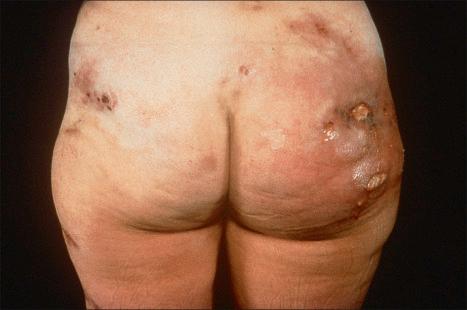
The nodules may be erythematous and are frequently associated with ulceration and the spontaneous discharge of clear, serosanguinous, or oily fluid. Deeply penetrating sinuses associated with liquefaction of the subcutaneous tissues are an important complication. Extensive necrosis with development of a polycyclic ulcer mimicking pyoderma gangrenosum has also been reported.
Fever is a common accompaniment, and patients often have pulmonary problems including panacinar emphysema, chronic obstructive pulmonary disease, effusions, and embolic phenomena. Peripheral edema and anasarca are occasional manifestations. This is a particularly severe form of panniculitis, which has been successfully treated by the use of infusions of commercial α 1 -antitrypsin concentrate or liver transplantation. It is thought that many of the previously reported cases of Weber-Christian disease belong to this group.
Panniculitis in association with α 1 -antitrypsin deficiency has been induced by cryosurgery, pregnancy, cesarean section delivery, and clarithromycin leak at the site of intravenous application. In one patient with the enzyme defect, Sweet syndrome was followed by the development of acquired cutis laxa (Marshall syndrome). An acquired α 1 -antitrypsin deficiency panniculitis following liver transplantation has been reported, which was successfully treated with retransplantation of the liver.
α 1 -Antitrypsin (a glycoprotein of hepatic derivation) is a serine protease inhibitor (PI) that greatly modifies the effects of proteolytic enzymes, accounting for at least 90% of serum proteolytic enzyme inhibition. In addition to antitrypsin inhibition, it is also responsible for inhibition of proteinase 3, cathepsin G, α-defensins, chymotrypsin, collagenase, elastase, granzyme B, plasmin, thrombin, plasminogen activators 1 and 2, factor VIII, factor Xa, and kallikreins 7 and 14. Its deficiency has been associated with panacinar emphysema, noninfective (neonatal and adult) hepatitis, and cirrhosis. More recently, associations have also been described with cutaneous vasculitis, atopic dermatitis, psoriasis, nodular prurigo, and cold urticaria. It has been proposed that absence of the protease inhibitor is associated with unrestrained complement activation with increased inflammatory cell activity, endothelial injury, and resultant autolytic tissue damage.
Immunoglobulin (IgM) and complement (C3) have been identified in blood vessel walls in patients with this variant of panniculitis. The significance of this is uncertain.
The gene for α 1 -antitrypsin on chromosome 14 has in excess of 100 alleles and is inherited as an autosomal dominant. Deficiency occurs in between 1 : 3000 and 1 : 5000 of white North Americans. The genotypes are classified based on the speed of migration on electrophoresis gel (M = median, S = slow, and Z = very small). The MM genotype is most common, and individuals with normal activity are coded PiMM. The ZZ genotype is associated with deficient α 1 -antitrypsin activity and the panniculitis is usually found in PiZZ individuals. Instances of panniculitis in PiMZ, PiSZ, PiMS, PiSS, and Null patients, however, have also been recorded. Panniculitis may also develop as a consequence of dysfunctional α 1 -antitrypsin. Recognition of this particular form is of importance as serum α 1 -antitrypsin levels are normal and therefore the diagnosis can easily be missed.
The earliest changes consist of necrosis of the connective tissue in the reticular dermis and septa of the subcutaneous fat accompanied by a neutrophil polymorph inflammatory cell infiltrate ( Fig. 10.25 ). The histologic features of an established lesion are those of a predominantly acute panniculitis ( Fig. 10.26 ). The changes, which affect the septa and the paraseptal aspect of the lobule, are characteristically focal in nature. In acutely inflamed areas, large numbers of neutrophil polymorphs infiltrate the lobule. Fat necrosis is common, and a characteristic feature is said to be the presence of normal fat adjacent to necrotic and inflamed fat ( Figs 10.27 and 10.28 ). Special stains often show fragmentation and loss of elastic tissue. Z-type α 1 -antitrypsin polymers have been demonstrated in the lesional as well as unaffected fatty tissue by immunohistochemistry in a single patient. Foci of hemorrhage associated with vascular thrombosis may be present, but there is no evidence of active vasculitis ( Fig. 10.29 ). Elsewhere, a histiocytic infiltrate is conspicuous, involving both the deep vasculature and adjacent panniculus. Lipid-laden foamy macrophages are sometimes evident and multinucleate giant cells are occasionally found. Healing is by scarring.
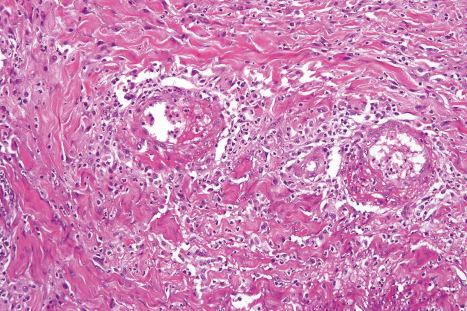
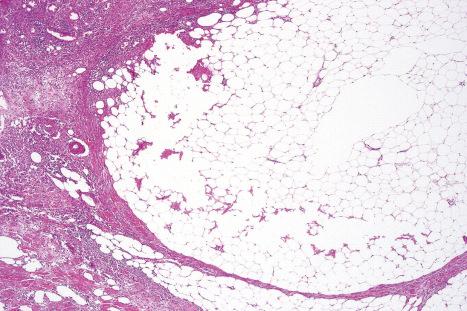
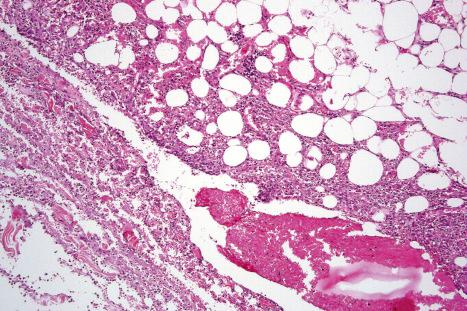
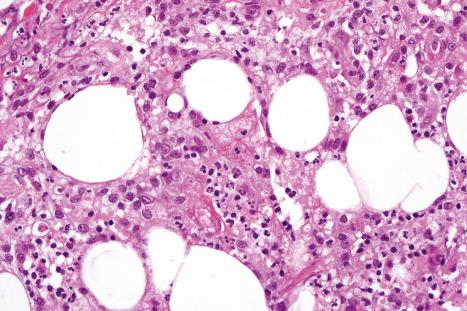
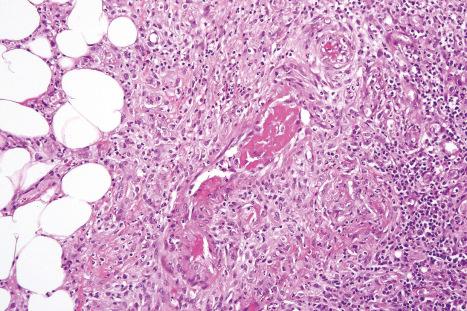
The clinical features may suggest traumatic or factitial panniculitis. The heavy neutrophil infiltrate can cause diagnostic confusion with an infectious etiology. In cases of doubt, special stains for microorganisms should be performed.
Factitial panniculitis is by definition self-induced and vigorously denied, and may be caused by mechanical, physical, or chemical means. The diagnosis is always worth considering in those patients with bizarre clinical lesions and inflammatory changes in the subcutaneous fat that defy ready classification. It should be particularly sought in those patients with panniculitis who have a known history of psychiatric illness or drug or alcohol abuse. Lesions are most commonly found on the more accessible sites including the buttocks and thighs.
Mechanical causes include local pressure and repeated blunt trauma; the latter may be readily recognized by the presence of obvious bruising. Cold is another possible cause of factitial panniculitis.
By far the most common etiology is the subcutaneous injection of chemical substances including drugs, oily materials, and organic matter. Panniculitis has been described as a complication of morphine and tetanus antitoxoid injections. Similarly, repeated injections of pentazocine cause a characteristic woody fibrosis of the skin and subcutaneous fat accompanied by deeply penetrating ulcers and hyperpigmented halos. Pentazocine abuse has been described, particularly in members of the medical profession. There appears to be a relationship with a personal or family history of diabetes mellitus. It has been suggested that peripheral ischemia may be the pathogenetic link. A similar problem has been described following injections of the opioid ketobemidone.
An important cause of factitial panniculitis is the repeated injection of oily materials including paraffin and liquid silicon (paraffinoma, sclerosing lipogranuloma, lipogranulomatous panniculitis) ( Fig. 10.30 ). Sclerosing lipogranuloma was a condition usually seen in the male genitalia that developed as a consequence of the injection of paraffin oil and related compounds into the penis in the mistaken belief that this would enhance erections. Povidone (polyvinylpyrrolidone), a synthetic dispersing or suspending agent which has been used in both pharmaceutical products and hair sprays, may result in a particular characteristic histologic variant of panniculitis. Associated features have included pulmonary lesions, lymphadenopathy, and hepatosplenomegaly. Organic substances that have been implicated in the etiology of factitial panniculitis include food matter, milk, and even feces.
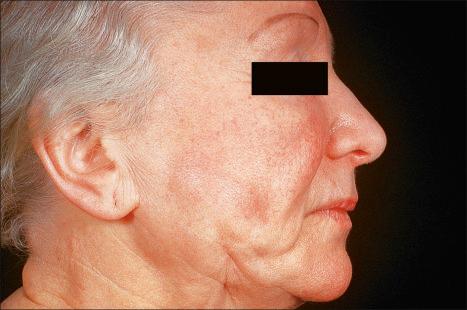
Nodular cystic fat necrosis is a distinct posttraumatic lesion that is seen predominantly in adolescent boys and middle-aged women. Lesions, which are usually found on the legs, are often associated with a history of trauma. A freely moving nodule(s) is often found on clinical examination.
Traumatic fat necrosis is a not uncommon condition and occurs predominantly in middle-aged or elderly females with large pendulous breasts. Its importance is that it may be clinically mistaken for a malignancy. In addition, it can be seen to involve the arms, trunk, buttocks, and thighs of the very obese.
A number of therapeutic injections have been associated with the development of panniculitis including interferon-beta (IFN-β), glatiramer acetate, nadroparin calcium, and granulocyte-colony stimulating factor. Aluminum granuloma may present as a panniculitis (see Chapter 14 ). Panniculitis has also been documented following vitamin K 1 injections. Two patients with factitial panniculitis caused by electroacupuncture have been described.
The histologic features of factitial panniculitis are not usually specific and depend to some extent upon the cause. In some instances, therefore, the changes are those of acute lobular inflammation associated with fat necrosis and a neutrophil polymorph infiltrate. In older lesions, mononuclear cells, lipid-laden histiocytes, and foreign body giant cells become predominant and sometimes the response becomes frankly granulomatous. On other occasions the septa may be primarily affected, thereby mimicking erythema nodosum. Calcification is occasionally evident. It is sometimes rewarding to view the sections with polarized light, as birefractile material may be identified, raising the possibility of the factitious nature of the condition.
Paraffinoma is characterized by the presence of round or oval spaces within the dermis and subcutaneous fat (‘Swiss cheese’ pattern) ( Fig. 10.31 ); careful examination may reveal foamy histiocytes or giant cells lining the edges of these cystic cavities ( Fig. 10.32 ). There is often associated dense fibrous scarring. Early lesions sometimes show a marked granulomatous component. Similar features have been described following a grease gun injury.
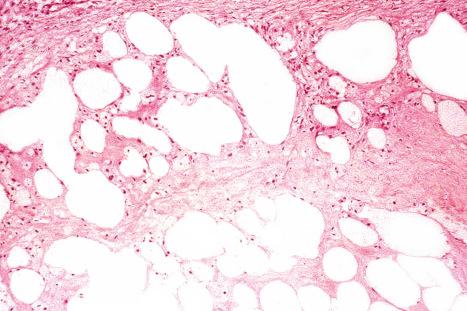
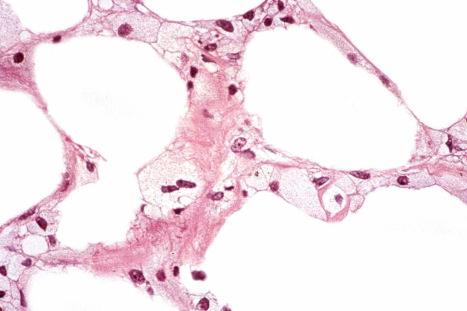
In panniculitis due to pentazocine abuse, the histologic features include dense dermal fibrosis accompanied by variable scarring of the subcutaneous fat. A ‘Swiss cheese’ appearance may be evident. Small-vessel thrombosis is frequently present.
Povidone panniculitis is characterized by histiocytic accumulation of gray-blue, Congo red-positive foamy material accompanied by necrosis and hemorrhage.
Lesions caused by blunt trauma show the features of an organizing hematoma. Granulomata and foci of hemosiderin pigment may additionally be present.
Nodular cystic fat necrosis is thought to have an ischemic pathogenesis. Histologically, it is characterized by an encapsulated nodule of necrotic (anucleate) fat cells ( Fig. 10.33 ). Variable inflammation is present.
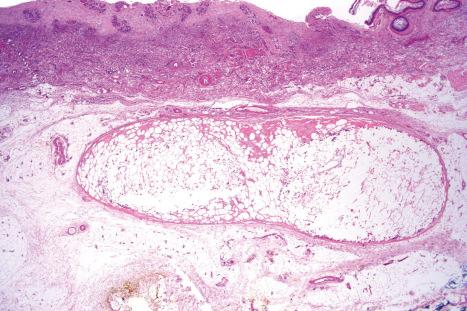
Post-surgical panniculitis is a variant of traumatic panniculitis developing at sites of previous surgical excision. It represents a variant of lobular panniculitis and is characterized histologically by pseudocystic degeneration and necrosis of adipocytes, the presence of foamy cells (lipophages), extravasation of erythrocytes, and deep-seated phlebitis. Fat necrosis with histiocytes (lipophages) and giant cells is a common histologic finding in specimens taken from sites of previous surgery of the subcutaneous fat (or deeper). Zelickson and Winkelmann have described this as lipophagic panniculitis. Hemosiderin deposits are also commonly found and, in many instances, fragments of suture material may be identified.
The histologic features of traumatic fat necrosis are not specific and are characterized by fat necrosis accompanied by a variable inflammatory cell infiltrate ( Figs 10.34 and 10.35 ). In early lesions this is predominantly composed of neutrophils, later replaced by lymphocytes and monocytes. Aggregates of lipophages are seen frequently and often the reaction becomes frankly granulomatous. Fat cysts are a common feature. With resolution, fibrosis takes place ( Fig. 10.36 ). As evidence of the traumatic nature of the lesion, foci of hemosiderin deposition are not uncommon ( Fig. 10.37 ). Occasionally, the presence of fat necrosis is complicated by focal calcification ( Fig. 10.38 ).
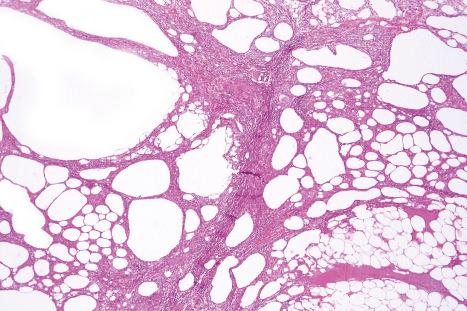
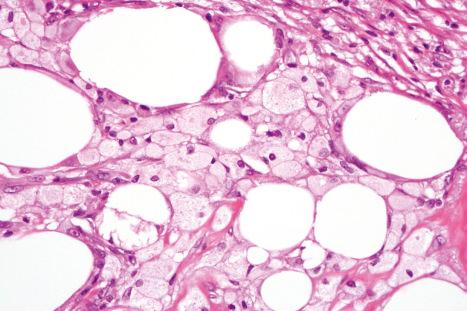
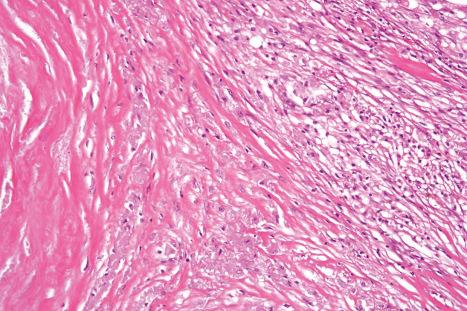
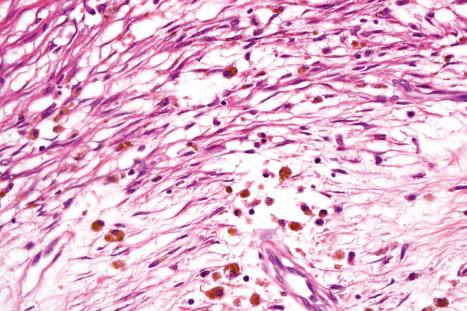
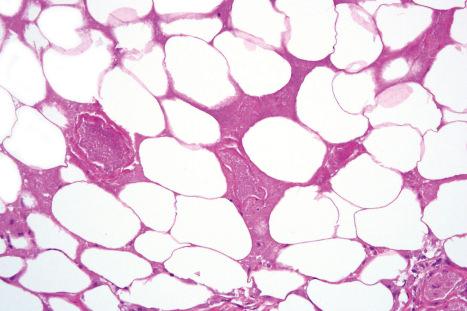
Panniculitis after subcutaneous injection of interferon-beta can mimic histologically erythema nodosum, lupus panniculitis, and pancreatic panniculitis.
Glatiramer acetate-induced panniculitis is characterized histologically by a predominantly lobular inflammatory infiltrate composed of lymphocytes, plasma cells, and scattered neutrophils and eosinophils in the background of lipophagic granulomata. Reactive germinal centers may also be seen.
Interferon-beta-induced panniculitis and glatiramer acetate-induced panniculitis are frequently associated with subsequent lipoatrophy.
This rare condition was originally described in infants and young children who developed tender, warm, erythematous plaques on exposed sites, namely, the cheeks and submental region, after experiencing low temperatures, and usually appeared within the first 72 hours after exposure. These plaques resolved spontaneously after 2–3 weeks, with no residual sequelae. The application of an ice cube to a child's skin may result in the development of similar lesions. Identical changes have also been described in infants following the sucking of ice lollies (popsicles; ‘popsicle panniculitis’). Increased saturated fat content having a higher melting point may precipitate the development of panniculitis in children. Furthermore, cold-induced panniculitis has also been reported in adult patients at sites of ice pack application (or cold therapy) to relieve local pain due to various conditions.
A similar phenomenon has been described in young women following horseback riding in cold weather (equestrian cold panniculitis); these patients develop indurated red-violaceous plaques on the superolateral aspect of the thighs following prolonged riding in freezing conditions ( Fig. 10.39 ). There is a tendency to ulcerate; healing is associated with postinflammatory hyperpigmentation and the development of depressed scars. It is thought that these lesions occur as a result of extremely cold temperatures combined with the effect of noninsulated, but tight-fitting, clothes which impair the circulation around the thighs. Risk factors for the development of equestrian cold panniculitis include young age, active smoking, tight clothing, and long periods of riding. Two patients with cold agglutinins and this condition have also been described.
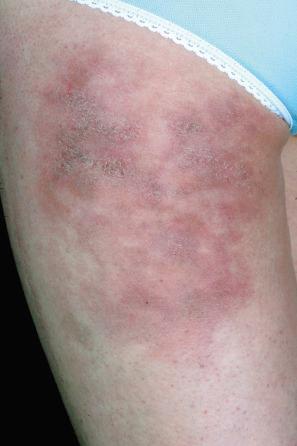
Chilblains (perniosis) also represent localized, abnormal inflammatory responses to the cold. They have an acral distribution (e.g., dorsal surfaces of the fingers and toes) and present as pruritic erythematous lesions, which may blister or ulcerate.
The features of cold panniculitis are most noticeable at the interface between the dermis and subcutaneous fat ( Fig. 10.40 ). The infiltrate, which contains lymphocytes, histiocytes, and neutrophils, extends from a perivascular location into the adjacent fat, where it is associated with adipocyte necrosis and the development of small cysts ( Fig. 10.41 ). Excess hyaluronic acid may sometimes be present. Granulomata are not usually conspicuous. The blood vessels show thickening of their walls and endothelial swelling, but frank vasculitis is not a feature. The combination of a superficial and deep perivascular and periadnexal lymphocytic inflammatory cell infiltrate coupled with mucin deposition and superficial lobular lymphocytic panniculitis can mimic lupus erythematosus.
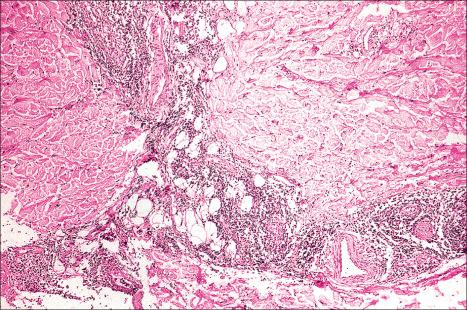
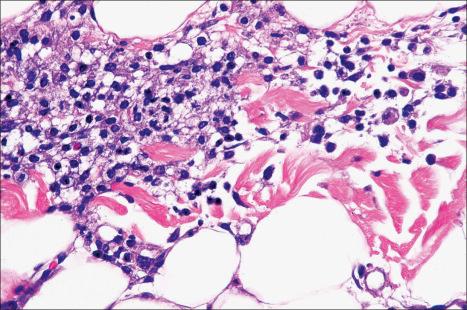
The histologic features of perniosis include intense papillary dermal edema and a superficial perivascular mononuclear infiltrate. The blood vessel wall characteristically shows very marked edema and often there is fibrin deposition.
Cytophagic histiocytic panniculitis (panniculitis associated with hemophagocytic syndrome) was originally described as a serious disorder of immune dysregulation. It may develop in association with a number of underlying conditions including viral infections such as cytomegalovirus and Epstein-Barr virus. HIV infection has also rarely been incriminated. Bacteria, fungi, and parasites are sometimes of etiological significance. The condition has been described as a complication of phenytoin therapy, following bone marrow transplantation, in systemic lupus erythematosus (SLE), and as an adverse reaction to interferon-alpha (IFN-α) therapy. Some examples in the earlier literature were described as Weber-Christian disease.
Of particular importance, the hemophagocytic syndrome may also be associated with a number of malignancies, most commonly T-cell lymphoma (nodal or cutaneous). It is likely that many of the cases of the entity described in the past represent examples of lymphomas including subcutaneous panniculitis-like T-cell lymphoma, nasal-type extranodal natural killer/T-cell lymphoma, and, particularly, gamma delta T-cell lymphoma. Rarely, an underlying systemic B-cell lymphoma has been incriminated. Most patients are immunosuppressed; however, very exceptionally, the cause is unknown (idiopathic histiocytic cytophagic panniculitis). It is, therefore, of particular importance that all patients diagnosed with this condition are investigated to exclude an underlying lymphoma, particularly of T-cell lineage.
Clinically, the cutaneous manifestations of cytophagic histiocytic panniculitis include erythematous to violaceous or hemorrhagic nodules, which particularly affect the lower limbs and trunk ( Figs 10.42 and 10.43 ). In many patients, however, the distribution is much more widespread. Ulceration is sometimes seen. Severe localized or generalized edema may also be a feature. Constitutional symptoms including pyrexia, malaise, weight loss, fatigue, and myalgia may be present. Patients commonly develop hepatosplenomegaly, lymphadenopathy, hypertriglyceridemia, anemia, leukopenia, thrombocytopenia, and disseminated intravascular coagulopathy. Steatohepatitis may complicate exacerbation of cytophagic hemorrhagic panniculitis.
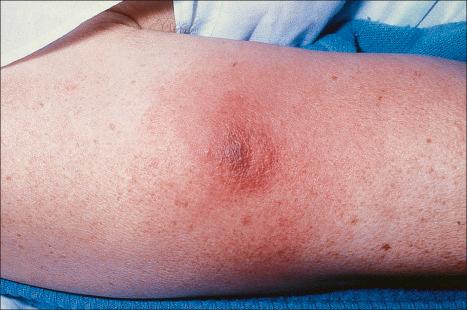
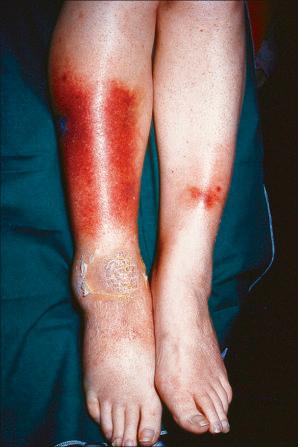
The course of the disease is variable and to some extent depends on the underlying cause. Some patients have a prolonged indolent disease over many years before progressing to clinical evidence of systemic hemophagocytosis. Rarely, patients may present with cutaneous lesions and a relatively benign illness ; others have a rapidly progressive condition with hemophagocytosis and its sequelae from the outset. The mortality rate for these last patients is high. In addition to the direct effects of bone marrow failure and disseminated intravascular coagulation, systemic infections including opportunist bacteria and fungi are important causes of death.
Hemophagocytosis appears to develop as a consequence of excess T-cell cytokine production, either virally induced or as a consequence of neoplastic transformation. Tumor necrosis factor-alpha (TNF-α) and IL-2 may be of particular importance. Perforin gene mutation has been detected in a child with cytophagic lymphocytic panniculitis associated with fatal hemophagocytic lymphohistiocytosis. In addition, a missense mutation in the STX11 gene was detected in another child with cytophagic histiocytic panniculitis with a relapsing familial form of hemophagocytic lymphohistiocytosis.
Histologically, the lesions are characterized by an infiltrate of histiocytes with abundant eosinophilic cytoplasm and uniform, variably hyperchromatic or vesicular nuclei containing small nucleoli. Variable numbers of lymphocytes and neutrophils are also present. Although the distribution is predominantly lobular, septal involvement is usually apparent and the lower dermis is also often involved ( Fig. 10.44 ). Red cell extravasation is typically present, and frequently the lesions are frankly hemorrhagic. Erythrophagocytosis is invariably a feature and phagocytosis of lymphocytes or nuclear debris is also often evident ( Fig. 10.45 ). The enlarged and distended histiocytes are sometimes described as ‘bean-bag’ cells ( Fig. 10.46 ). Giant cells and granulomata are not usually a feature unless there is concomitant fat necrosis. Lymphoid nuclear atypia is evident in those cases in which a T-cell lymphoma is present (see below).
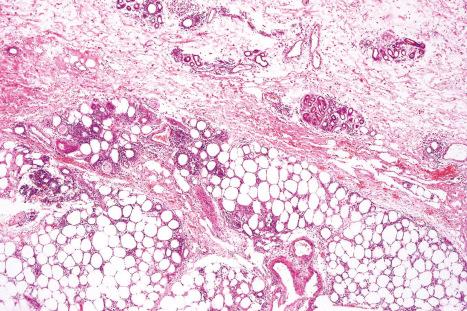
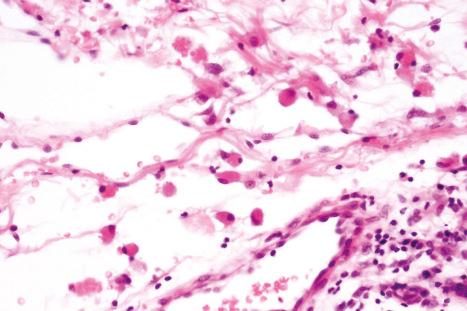
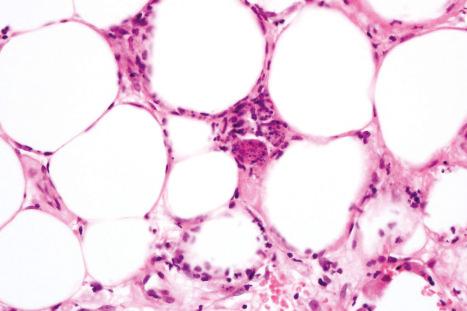
Cytophagic histiocytic panniculitis must be distinguished from other conditions in which erythrophagocytosis or hemophagocytosis may be a feature including subcutaneous T-cell panniculitic lymphoma, angiocentric lymphoma, and cutaneous Rosai-Dorfman disease.
In subcutaneous panniculitic T-cell lymphoma, the lymphocytes show cytological atypia with karyorrhexis and mitotic activity ( Fig. 10.47 ). In children with cytophagic histiocytic panniculitis, a clonal reactive T cell proliferation mimicking panniculitis-like T cell lymphoma has been reported in exceptional cases, likely following a viral infection. Angiocentric T-cell lymphoma is characterized by an angioinvasive and frequently angiodestructive atypical lymphoid infiltrate usually accompanied by widespread coagulative necrosis. In cutaneous Rosai-Dorfman disease, the infiltrate is usually centered on the dermis. Lymphophagocytosis is often marked, but erythrophagocytosis is not usually present. The histiocytes are characteristically S100 protein positive.
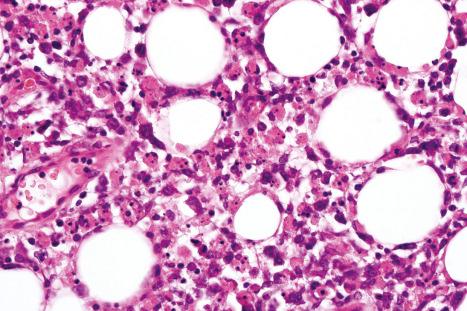
Whipple disease is a rare condition which most often affects males and is due to infection with the bacillus Tropheryma whippeli . It is characterized by small intestinal involvement leading to malabsorption accompanied by fever and arthritis, although virtually any organ system may be affected. Cutaneous lesions include hyperpigmentation, erythroderma, purpura, vasculitis, erythematous and urticarial lesions, eczematous dermatitis, and lichenoid granulomatous lesions. Exceptionally, subcutaneous nodules have been described with occasional symmetrical distribution on inner thighs and forearms.
Involvement of the subcutaneous fat presents as a predominantly septal ‘panniculitis’ characterized by a mixed inflammatory cell infiltrate consisting of lymphocytes, neutrophils, and foamy periodic acid-Schiff (PAS)-positive histiocytes, occasionally accompanied by formation of granulomas. Similar changes can also be present in the dermis.
Electron microscopy reveals degenerate bacilli within membrane-bound vesicles in the cytoplasm of the histiocytes.
Polymerase chain reaction (PCR) and immunohistochemical techniques can be used as a diagnostic aid.
Pancreatic panniculitis is rare, occurring in 1–3% of patients with underlying pancreatic disease. Recognizing the association of subcutaneous fat necrosis (metastatic fat necrosis) with pancreatic disease is of particular importance because sometimes the underlying pancreatic process is clinically silent. Furthermore, pancreatic panniculitis can be the presenting sign of an underlying pancreatic disorder in as many as 35% of the patients. The pancreatic diseases include acute pancreatitis, chronic pancreatitis, pancreatic pseudocyst, pancreatic divisum, and pancreatic neoplasms (mostly acinar cell carcinoma, but also ductal carcinoma, neuroendocrine carcinoma, intraductal papillary mucinous neoplasm, and mucinous adenocarcinoma). Pancreatic panniculitis can also develop as a complication of endoscopic retrograde cholangiopancreatography. In addition, pancreatic panniculitis has been described as a possible adverse drug reaction following renal transplantation for SLE, simultaneous pancreas-kidney transplantation for type I diabetes, and following liver transplantation. Pancreatic panniculitis has been reported following l -asparaginase treatment for acute lymphoblastic leukemia, peginterferon/ribavirin/telaprevir combination treatment for hepatitis C, but also in a patient with nephrotic syndrome due to rapidly progressing glomerulonephritis and in a patient with DiGeorge syndrome. There are two additional reports of the disease developing in a background of lupus erythematosus.
Patients present with multiple, exquisitely tender nodules, which are erythematous or violaceous in appearance ( Figs 10.48 and 10.49 ). The lower extremities, buttocks, and trunk are most often affected, although occasionally the upper arms, thorax, and scalp are involved. Occasionally, the nodules ulcerate and release a creamy or oily discharge ( Fig. 10.50 ). Joint manifestations (pain and swelling) are an important feature of this syndrome (also designated pancreatitis panniculitis polyarthritis syndrome), occurring in approximately 54% (pancreatitis-associated) to 88% (pancreatic carcinoma-associated) of patients. The ankles are most often affected, but the knees, elbows, wrists, metacarpophalangeal, and metatarsophalangeal joints are occasionally involved. A single case with chondronecrosis and osteonecrosis has been reported. Additional features include pleural effusions (in 25%), ascites (in 30%), and very occasionally, pericardial effusion. Intramedullary fat may also be affected and intestinal involvement has rarely been documented. Peripheral blood eosinophilia is quite a common laboratory finding (19% in pancreatitis-associated; 65% in pancreatic carcinoma-associated). Males are affected more often than females (pancreatitis 2 : 1; carcinoma 7 : 1), and patients are most often in the fourth, fifth, or sixth decade. This disease is associated with a high mortality, 42% in pancreatitis-associated variants and up to 100% in those cases presenting with an underlying carcinoma.
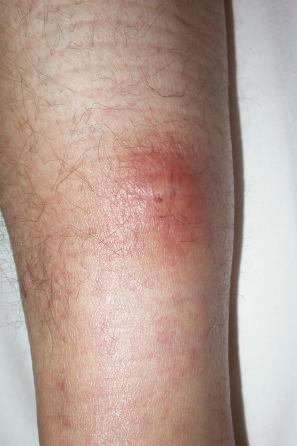
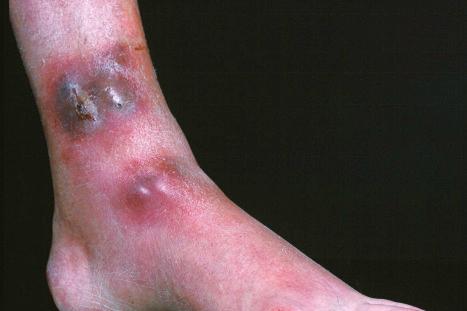
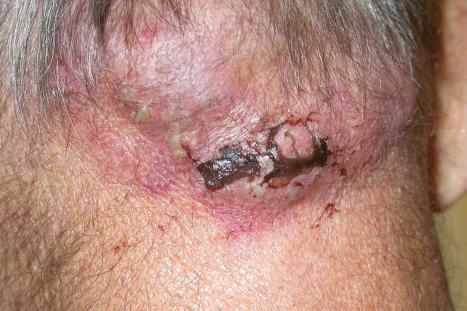
The development of subcutaneous fat necrosis in association with pancreatic disease is due to the release into the peripheral circulation of trypsin, lipase, phospholipase, and amylase. It has been postulated that trypsin damages the vasculature, particularly in dependent sites, thereby permitting lipase to enter the surrounding tissues. In vivo evidence suggests that this may be too simplistic a viewpoint. Serum lipase levels do not always correlate with subcutaneous fat necrosis, and examples of patients with fat necrosis and normal serum lipase levels have been documented. The reports of Wilson et al. and Simkin et al., however, provide striking in vivo evidence to support a pathogenetic role for released pancreatic enzymes.
Histologically, the features are very distinctive and are identical to those seen in the peripancreatic adipose tissue following an episode of acute hemorrhage pancreatitis ( Fig. 10.51 ). Although very early changes can show features of septal panniculitis without fat necrosis or vasculitis, most frequently, however, the changes are lobular in distribution and are characterized by the presence of ghost cells ( Fig. 10.52 ). The latter are anucleate, composed of amorphous granular debris, and often show a rim of eosinophilia ( Fig. 10.53 ). Stippled basophilia due to calcification is commonly found ( Fig. 10.54 ). Ghost-like adipocytes can be surrounded by peripheral eosinophilic striations consistent with the Splendore-Hoeppli reaction. A neutrophil polymorph response is usually evident around the foci of fat necrosis, and hemorrhage is an almost invariable feature ( Fig. 10.55 ). The uninvolved surrounding fat is heavily infiltrated by acute and chronic inflammatory cells including large numbers of macrophages, many of which have foamy cytoplasm due to ingested lipid, and occasional multinucleate giant cells ( Fig. 10.56 ). Birefringent crystals have been described in the mesenteric fat and within affected joints but not in the subcutaneous fat. Generally, there is no evidence of a vasculitis. However, the presence of muscular arteritis in the connective tissue septa at the periphery of inflamed fat lobule has exceptionally been reported.
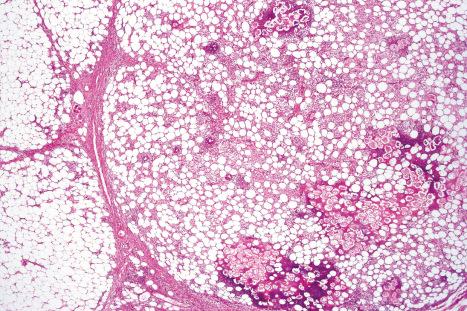
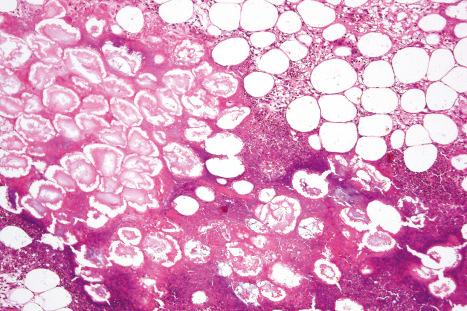
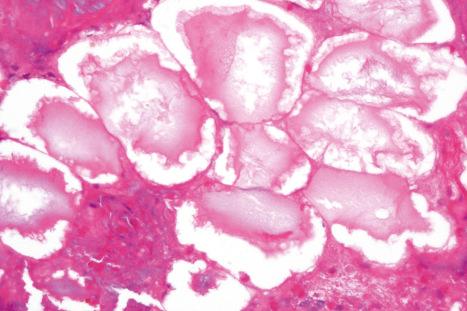
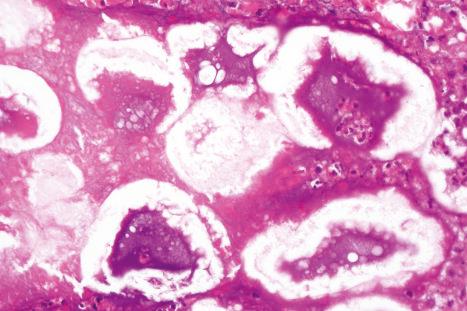
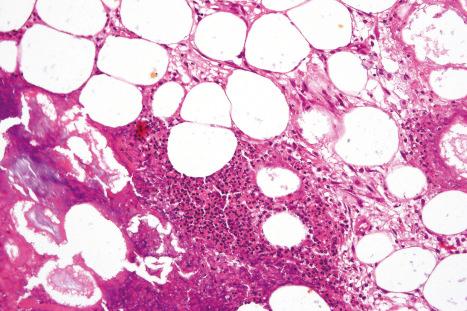
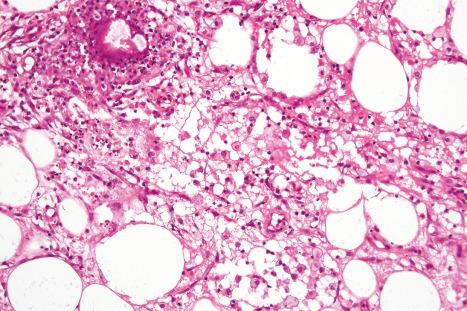
Pancreatic panniculitis can be complicated, albeit in isolated cases by infection with Corynebacterium tuberculostearicum .
Some deep fungal infections including aspergillosis and subcutaneous injections of interferon beta can induce a histologic picture mimicking pancreatic fat necrosis. Special stains for microorganisms and close clinicopathological correlation usually allow distinction to be made.
This uncommon disease presents in full-term or post-term neonates in the first few weeks of life. Affected babies develop painless subcutaneous nodules measuring from a few millimeters to several centimeters in diameter. The overlying skin may appear normal or be erythematous or violaceous. Lesions are symmetrical and distributed over bony prominences, the arms, shoulders, buttocks, thighs, and cheeks ( Fig. 10.57 ). The nodules frequently soften and become fluctuant, occasionally liquefying. The disease is usually self-limiting and benign, with spontaneous resolution occurring within a period of weeks to months in the majority of cases. An exceptional example of a recurrent subcutaneous fat necrosis of the newborn, developing several weeks after the clearance of initial lesions at distant sites, has been reported.
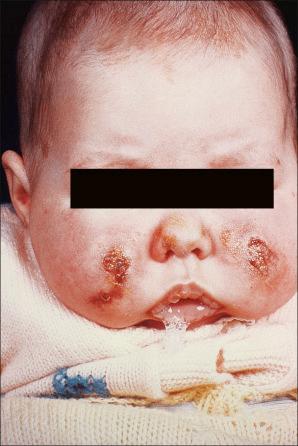
Subcutaneous fat necrosis of the newborn is associated with hypercalcemia from 29% to 69% of the patients, and much less frequently with dyslipidemia, thrombocytopenia, hyperglycemia, and lactic acidosis. Hypercalcemia may be asymptomatic and associated with failure to thrive, fever, vomiting, irritability, and seizures. Calcium deposits have been described in the kidneys, liver, inferior vena cava, and heart. Delayed onset of hypercalcemia up to 6 months after occurrence of the subcutaneous fat necrosis of the newborn is also possible. Exceptionally, this disease can prove fatal.
The pathogenesis of the hypercalcemia is unknown. A number of theories have been proposed including calcium release from resolving plaques, elevated parathormone and prostaglandin E2 levels, increased vitamin D sensitivity, and most recently, lesional histiocytic production of excessive 1,25-dihydroxyvitamin D 3 with resultant increased intestinal absorption of calcium.
The cause of subcutaneous fat necrosis of the newborn is unknown, but most cases are related to some form of fetal distress, including obstetric or other birth trauma, cord accidents, meconium aspiration, infections, hypothermia, placenta previa, cesarean section, and neonatal asphyxia. Pre-eclampsia and maternal diabetes have also been associated with this condition. A recent prospective study established higher birth weight to be an independent risk factor for subcutaneous fat necrosis in asphyxiated newborns. A primary abnormality of subcutaneous fat may also be of some importance. Neonatal fat is characterized by elevated levels of saturated fatty acids which have a high melting point and are therefore susceptible to precipitation as a consequence of neonatal hypothermia. Deficiency of brown fat has also been proposed as a potential etiological factor. Although not histologically confirmed, a case of simultaneous development of sclerema neonatorum and subcutaneous fat necrosis of the newborn was described in an infant following cesarean section for fetal distress, hypothermia, neonatal respiratory distress, and hypoglycemia.
Subcutaneous fat necrosis has also been described after hypothermic cardiac surgery, as a complication of congestive heart failure in an infant with ventricular septal defect and patent ductus arteriosus, associated with maternal diabetes, increased blood pressure, smoking, thrombosis-related risk factor, a possible complication of cocaine abuse, following the in partum use of calcium channel blockers, and as a consequence of prolonged exposure in very cold weather.
The histologic changes are characteristic. The subcutaneous fat is the scene of intense necrosis. Individual adipocytes are swollen and contain abundant radially arranged eosinophilic crystalline spaces resulting from dissolved lipid ( Figs 10.58 and 10.59 ). The crystals are largely composed of triglycerides. There is a heavy inflammatory cell infiltrate comprising polymorphs, lymphocytes, histiocytes, and numerous foreign body giant cells ( Fig. 10.60 ). Neutrophilic granulocytes are usually absent or form a minor fraction of the inflammatory cell infiltrate. Nevertheless, a neutrophil-rich variant of subcutaneous fat necrosis of the newborn has been reported with neutrophilic granulocytes representing the predominant cell type (over 75%) in the inflammatory infiltrate. Such examples mimic infective panniculitis and require exclusion of infection by special stains and/or cultures. Large numbers of eosinophils have been described in two cases. Multinucleated giant cells containing eosinophilic granules in their cytoplasm have also been reported. The significance of these granules is unknown, and their origin from degranulating eosinophils has been postulated. Older lesions may show fibrosis and foci of calcification. Systemic involvement is sometimes present.
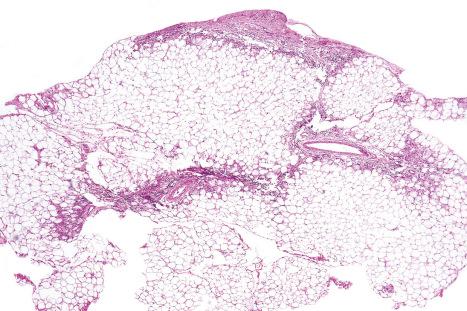
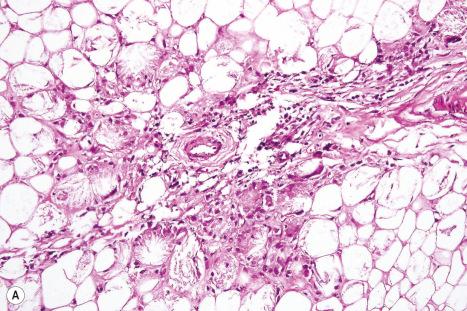
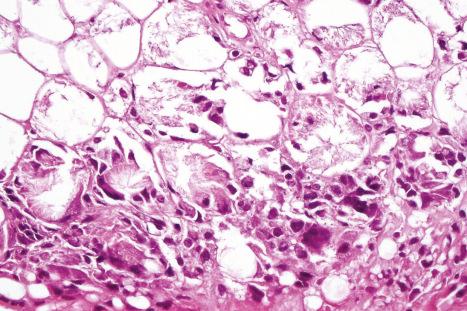
It is of interest to note that identical histologic features were seen a number of years ago in the poststeroid panniculitis syndrome. This condition occurred in children who had been treated for rheumatic fever or glomerulonephritis with very large doses of steroids; sudden withdrawal of the steroids resulted in the development of subcutaneous swellings up to 4 cm across on the cheeks, arms, and trunk. The disease is now of historic interest only due to the standard practice of steroid taper when withdrawing the drug. The skin overlying the nodules was erythematous, warm, and itchy. In mild cases, the panniculitis resolved spontaneously; in more severe examples, it subsided following the reintroduction of steroids. Poststeroid panniculitis has also been reported in an adult patient.
Sclerema neonatorum is a very rare condition associated with high morbidity and mortality (75–90%). It is sometimes confused with, and therefore must be distinguished from, subcutaneous fat necrosis of the newborn. Infants present in the first week of life (average age of onset, 4 days; range, birth to 70 days) with a diffuse, rapidly spreading, waxlike thickening, and induration of the subcutaneous fat, resembling lard. This usually commences about the buttocks, thighs, and trunk, and often spreads to involve the whole body, excluding the palms, soles, and genitalia. The fat is typically tethered to the underlying fascia and the skin cannot be grasped between the fingers. Pitting edema is not a feature. A delayed onset of sclerema neonatorum several months after delivery is exceptional.
Affected infants are usually hypothermic, but body temperature may be normal or, rarely, raised. Some of the infants are premature, but they are a minority. The children commonly have some other associated illness, such as septicemia, pneumonia, diarrhea, dehydration, intestinal obstruction, congenital heart disease, or other congenital malformations. A patient with both sclerema neonatorum and concurrent subacute fat necrosis of the newborn has been described.
The etiology and pathogenesis of this condition are uncertain. It is thought that the structural alterations of the subcutaneous fat probably predate the development of the clinical features. Neonatal subcutaneous fat is characterized by a higher content of saturated fatty acids (palmitic and stearic) and a lower content of unsaturated fatty acids (oleic) than adult subcutaneous fat. It also has higher melting and solidification points. It has been suggested that infants with sclerema neonatorum have an inadequately developed enzyme system for converting saturated to unsaturated fatty acids. It is thought that this, in association with stress, might result in the precipitation of triglycerides and consequent solidification of the subcutaneous fat. It has been proposed that redistribution of blood flow to the systemic circulation with resultant relative ischemia of the subcutaneous fat may be of pathogenetic importance. Sclerema neonatorum is characterized by increased blood lipid peroxidation and diminished superoxidase dismutase activity, which raises the possibility that free radicals may play a role in its pathogenesis. There is no evidence of vasculitis.
The histologic features are surprisingly bland. The subcutaneous fat is greatly thickened and the fibrous septa are broader than normal. The adipocytes, which are increased in size, may contain radially orientated fine crystals identical to those described in subcutaneous fat necrosis of the newborn although often they are inconspicuous. In contrast to the latter condition, however, there is no necrosis or significant inflammatory cell infiltrate. Calcification is rarely a feature. The dermis may appear sclerotic with hyalinization and the epidermis atrophic with loss of the rete ridges.
Changes in the subcutaneous fat similar to sclerema neonatorum, characterized by the radial arrangement of nonpolarizable needle-shaped crystals within adipocytes, have been reported in an adult patient as an adverse reaction to gemcitabine treatment for metastatic pancreatic cancer.
Oxalosis, in which there is widespread deposition of calcium oxalate in the tissues, may represent a primary metabolic disease or a secondary phenomenon due to increased intake of oxalate precursors or defective excretion. Secondary oxalosis can also result from pyridoxine deficiency, glycerol infusion, methoxyflurane anesthesia, excessive ascorbic acid, extensive hemodialysis, peritoneal dialysis, and ethylene glycol poisoning.
Primary oxalosis, which is associated with overproduction of oxalate, is an autosomal recessive condition and includes three subtypes:
Type I, which is most often encountered, develops as a result of deficiency of the hepatic enzyme alanine:glyoxylate aminotransferase with resulting increased urinary excretion of oxalate, glycolate, and glyoxylate.
Type II ( l -glyceric aciduria) results from cytosolic d -glycerate dehydrogenase and glyoxylate reductase deficiencies with associated increased urinary excretion of l -glycerate and oxalate accompanied by normal glycolate and glyoxylate excretion.
Type III develops as a result of primary small intestinal disease associated with excessive oxalate reabsorption.
Calcium oxalate crystal deposition occurs most commonly in the kidneys (calcium oxalate stones and chronic renal failure). With the onset of the latter, hyperoxalemia develops with resultant deposition of oxalate crystals in the blood vessels, retina, myocardium, cardiac conducting system, central nervous system, peripheral nerves, bones, and joints.
Cutaneous manifestations may occur in both primary and secondary forms. Lesions most often result from vascular involvement, patients presenting with acrocyanosis, livedo reticularis, Raynaud phenomenon, and distal gangrene ( Fig. 10.61 ). Ulceronecrotic lesions reminiscent of calciphylaxis have also been documented. Less often, crystals are deposited in the skin of the face and the fingers as miliary deposits, as dermal/subcutaneous nodules or as painful subungual nodules. Exceptionally, generalized cutaneous nodules have been documented. Vascular involvement is said to be more common in patients with primary disease whereas cutaneous extravascular lesions are predominantly seen in patients with secondary disease.
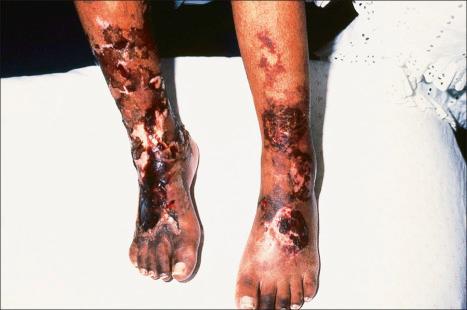
Calcium oxalate crystals are yellow to brown, radially arranged, needle-shaped or rectangular in shape ( Figs 10.62 and 10.63 ). In the skin, they may be found in the reticular dermis or within the subcutaneous fat. Vascular involvement may also be seen where the media of arteries is predominantly affected ( Fig. 10.64 ). Less commonly, crystals may be seen within the lumina of smaller arteries or arterioles. The crystals show striking yellow or blue birefringence when examined in polarized light. They are sometimes accompanied by a foreign body giant cell reaction, particularly when present as dermal or subcutaneous deposits. In those cases associated with gangrene or livedo reticularis, fibrin thrombi may also be detected.
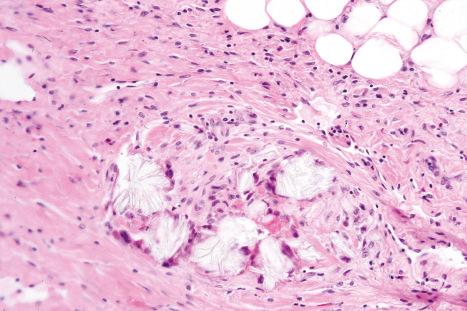
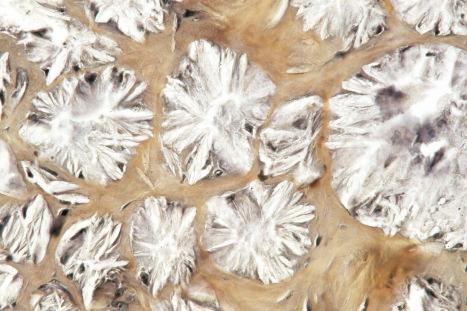
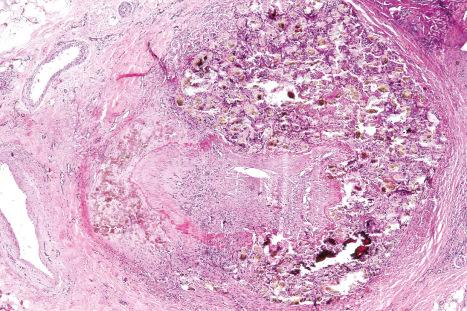
Calciphylaxis was originally defined by an experimental model in rats, in which sensitization with parathormone or dihydrotachysterol followed by the injection of a challenging agent such as a metal salt resulted in localized necrosis and calcification. The term was subsequently adopted to describe a condition in which an abnormality of calcium/phosphate metabolism is followed by calcification of the vasculature of the subcutaneous fat with subsequent thrombosis accompanied by extensive skin necrosis.
Calciphylaxis presents clinically as an often bilateral and symmetrical, pruritic, and frequently painful/tender eruption most often affecting the lower limbs ( Fig. 10.65 ). Less often, lesions may affect the breasts, buttocks, abdomen, and penis. Calciphylaxis shows female predominance (about 2 : 1) and most commonly develops in the fifth decade of life. Lesions are often well-delineated, livedoid, violaceous plaques and nodules associated with ischemic necrosis of the underlying tissues, sometimes extending down to the fascia. Ulceration is typically present, and sometimes bullae are a feature. Gangrene and autoamputation may accompany acral involvement. Intestinal involvement with massive hemorrhage has exceptionally been documented.
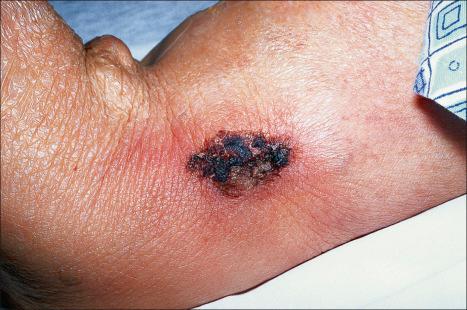
Calciphylaxis is associated with considerable morbidity and a high mortality of up to 60%. The majority of patients succumb to secondary infection. Calciphylaxis due to the end-stage kidney disease can exceptionally develop in children.
The precise mechanism by which the subcutaneous vasculature undergoes calcification is uncertain but is probably multifactorial. In the majority of patients, however, sensitization occurs as a consequence of abnormal calcium/phosphorus metabolism in a setting of chronic renal failure and secondary or tertiary hyperparathyroidism. Frequently, the patients are undergoing dialysis. Less often, there is a background of primary hyperparathyroidism or hypervitaminosis D. Although in many patients calcium deposition occurs in association with an increased calcium-phosphorus product, in a significant proportion of patients calcium and phosphorus levels are normal. It has been suggested that in such patients the calcification develops as a direct response to excess parathormone or vitamin D. Challenging agents resulting in the vascular precipitation of calcium salts are unknown, but a number of substances (including albumin, corticosteroids, warfarin, and immunosuppressives) have been incriminated. Calciphylaxis has also been described in association with decreased functional protein C. Rarely, the condition has presented in a patient with no evidence of a renal disorder or increase in parathormone level. Diabetes, obesity, autoimmune diseases (rheumatoid arthritis, systemic lupus erythematosus, antiphospholipid syndrome), malignant tumors, giant cell arteritis, as well as alcoholic liver disease have been implicated in these patients.
Histologically, the characteristic feature is calcification of the small- to medium-sized arteries and arterioles ( Figs 10.66 and 10.67 ). Calcified debris may sometimes be present within the lumina, and occasionally the vessels are thrombosed ( Fig. 10.68 ). Intimal fibroblastic proliferation with luminal narrowing has also been described ( Fig. 10.69 ). Hemorrhage within the subcutaneous fat may be seen and fat necrosis accompanied by a lobular lymphohistiocytic infiltrate has been documented in a number of cases ( Fig. 10.70 ). Interstitial calcification is only rarely a feature. Exceptionally, pseudoxanthoma elasticum-like changes have been documented. In a related phenomenon, epidermal and follicular calcification have been described in the absence of vascular lesions in a patient with toxic epidermal necrolysis in a background of hyperparathyroidism.
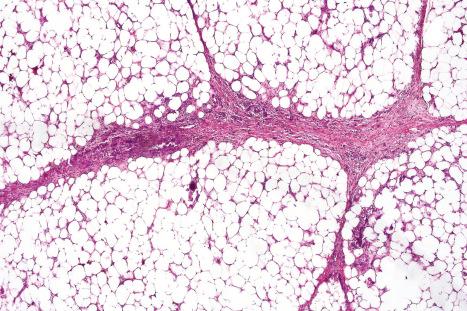
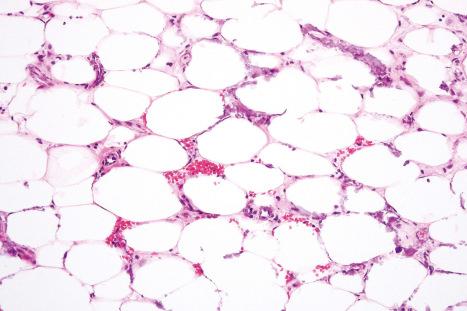
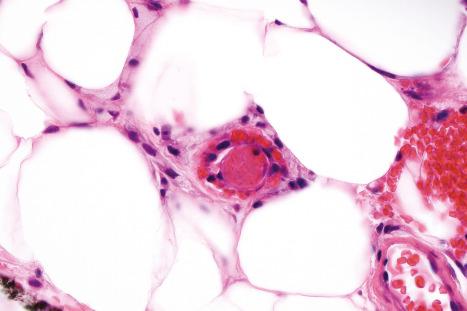
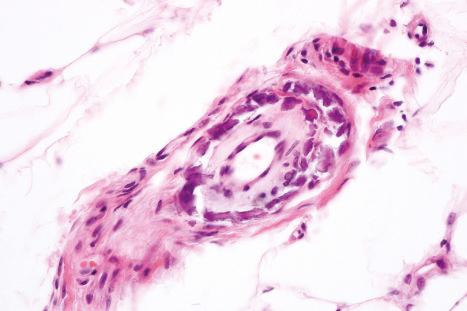
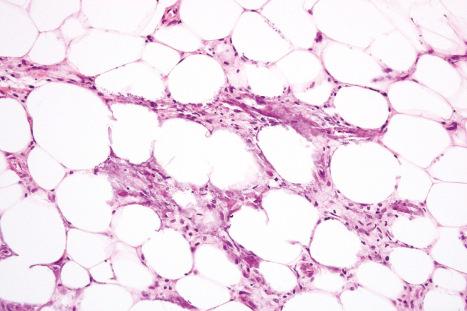
Calcification involving small arteries and arterioles not accompanied by thrombosis has been described in patients with nephrogenic systemic fibrosis. Furthermore, incidental vascular calcifications can also be found in patients with peripheral vascular disease, renal insufficiency, and diabetes mellitus.
Gouty panniculitis is an exceedingly rare cutaneous manifestation of gout characterized by the deposition of monosodium urate crystals in the subcutis. The most common presenting features are indurated, occasionally painful plaques or nodules with a tendency to ulcerate with subsequent drainage of chalky material. Although any site can be affected, there is a predilection for lower extremities. A disseminated variant has been reported. Gouty panniculitis is more common in males (M/F, 5 : 1) and typically develops in the fifth decade of life. Although generally a late manifestation of chronic gout, gouty panniculitis can also be an initial manifestation of the disease. Hyperuricemia is present in the vast majority of patients.
On histology, gouty panniculitis presents as a crystalline lobular panniculitis. In formalin-fixed specimens, amorphous material surrounded by variably abundant granulomatous inflammation can be appreciated in a lobular distribution. Extension into the deep dermis is not uncommon. Direct detection of crystals using polarized light requires either ethanol fixation or touch imprint slides. For a more detailed description of gout, including differential diagnosis, see Chapter 13 .
Nodular vasculitis (erythema induratum) is a rare condition which usually presents in young or middle-aged women, often in those with an erythrocyanotic circulation. Males are only rarely affected. Patients present with painful, tender, violaceous, indurated nodules particularly affecting the calves although the shins, feet, ankles, thighs, and upper limbs may sometimes be involved ( Figs 10.71 and 10.72 ). Lesions are often bilateral, and the overweight with fat calves are most often affected. Seasonal variation has been noted with an increased incidence being recorded in the cold winter months. Skin lesions often recur over many years. Ulceration is common and scarring with hyperpigmentation frequently accompanies healing ( Figs 10.73–10.75 ).
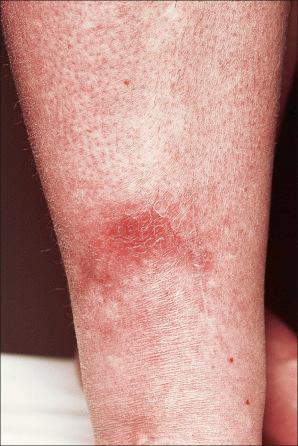
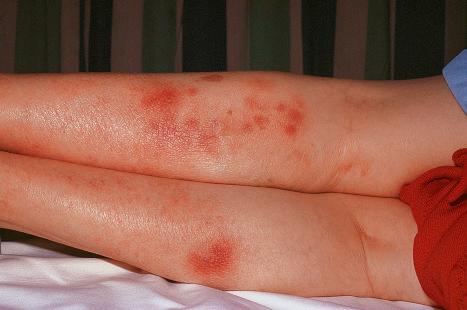
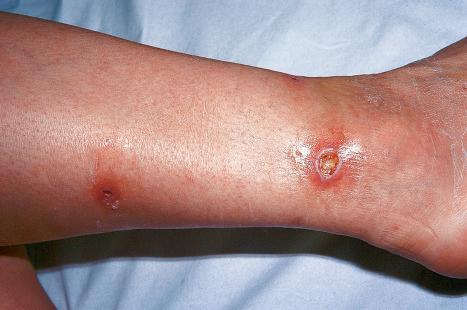
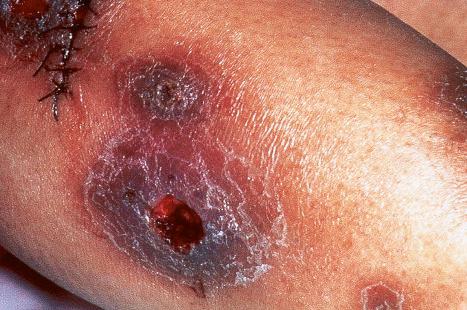
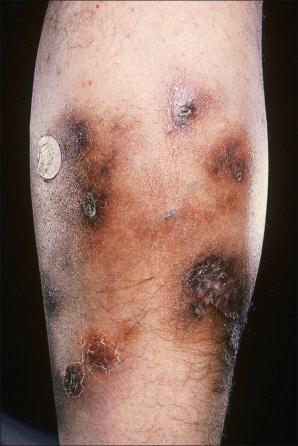
In those cases that represent a manifestation of underlying tuberculosis, the term erythema induratum (Bazin disease) is frequently applied. In this condition, there is invariable hypersensitivity to intradermal injection of purified protein derivative (PPD) at a dilution of 1 : 10 000 and a complete clearing of all skin lesions following treatment with antituberculous chemotherapy.
The relationship between erythema induratum and nodular vasculitis has for many decades been the subject of controversy. Similarly, the association of the former condition with an underlying tuberculous infection has been the subject of prolonged debate.
As outlined above, the more recent literature gives considerable support to the notion that occult tuberculosis is present in many patients with erythema induratum and that the two terms are, therefore, synonymous in a substantial proportion of cases. Thus, erythema induratum may be associated with evidence of active tuberculosis. Although cultures of lesions are invariably negative, the demonstration of Mycobacterium tuberculosis DNA by PCR in lesional tissue adds strong additional support to the proposal of an underlying tuberculous etiology.
Nodular vasculitis can, therefore, be regarded as a hypersensitivity reaction in which mycobacterial antigens are one important cause. Immune complex and delayed hypersensitivity mechanisms have both been proposed. Other predisposing factors for this condition have not yet generally been identified, although nodular vasculitis has been described in association with different infections (hepatitis B and C, Nocardia , Pseudomonas , Fusarium , Mycobacterium avium , M. chelonae , and Chlamydia ), acute and chronic myeloid leukemia, ulcerative colitis, Crohn disease, rheumatoid arthritis, systemic lupus erythematosus, superficial thrombophlebitis, hypothyroidism, and as an adverse drug reaction to propylthiouracil and etanercept (tumor necrosis factor alpha inhibitor). Bacille Calmette-Guérin (BCG) vaccination, distal painful peripheral neuropathy, and granulomatous aortic valve stenosis may on occasion be associated with erythema induratum of Bazin.
The histologic features combine septal and lobular changes ( Fig. 10.76 ). The presence of vasculitis has traditionally been regarded as a sine qua non for the diagnosis of nodular vasculitis (erythema induratum). Nevertheless, a study analyzing 101 biopsy specimens from 86 patients with clinical features of erythema induratum failed to detect the presence of vasculitis in 9.9% of specimens, even after examination of multiple serial sections.
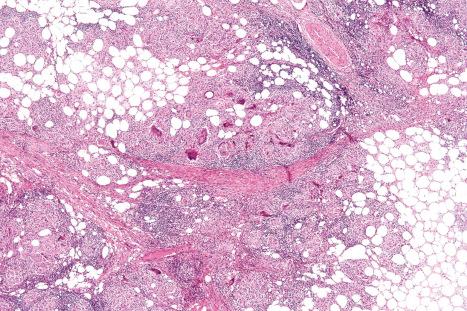
In a biopsy from an established lesion, the septa are widened and chronically inflamed ( Fig. 10.77 ). Acute vasculitis (affecting septal and lobular veins and venules) with a heavy inflammatory cell infiltrate consisting of neutrophils, lymphocytes, and histiocytes is typically present, sometimes accompanied by vessel wall necrosis and thrombosis ( Fig. 10.78 ). The most frequently affected are small lobular veins, followed by both septal veins and lobular venules. In addition, septal arteries may also be involved by the vasculitic process.
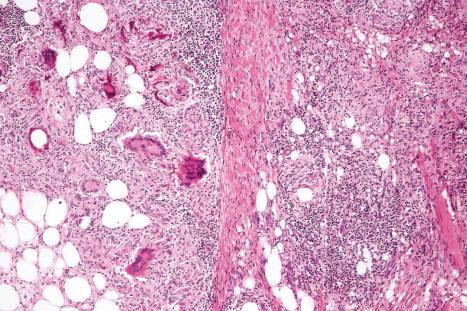
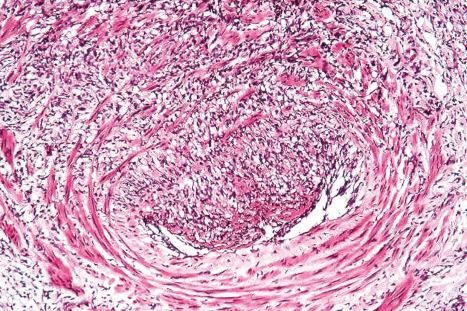
Occasionally, septal granulomatous inflammation can also be evident.
Lobular inflammation may occasionally be limited to a focal element adjacent to an acutely inflamed vessel. More frequently, however, it presents as nodular lesions scattered throughout the whole lobule or affecting multiple lobules. Fat necrosis is invariably present and is often florid. The features are varied and range from typical lipophagic fat necrosis to coagulative or, more rarely, caseation-like necrosis ( Figs 10.79 and 10.80 ). Neutrophils, lymphocytes, and histiocytes with xanthomatized forms are typically seen. Granulomata are often present, and giant cells of both foreign body and Langerhans type are frequently a feature ( Fig. 10.81 ).
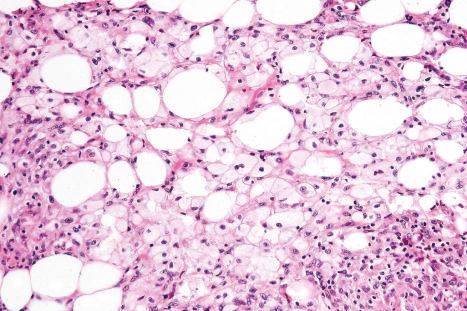
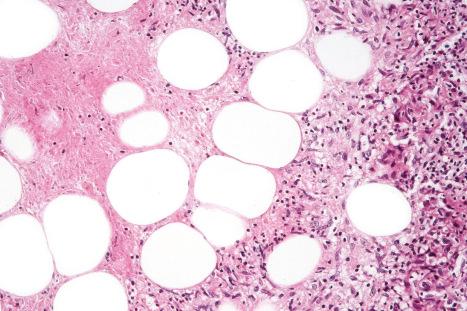
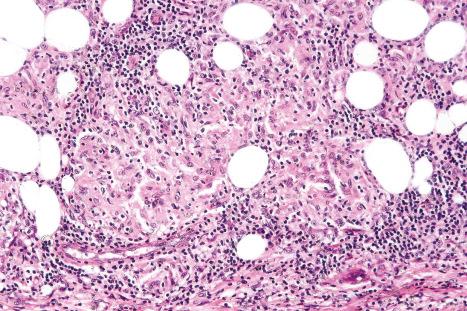
In biopsies from chronic or resolving lesions, fibrosis of both the septa and lobules is often present. Giant cells and granulomata may still be present.
Become a Clinical Tree membership for Full access and enjoy Unlimited articles
If you are a member. Log in here